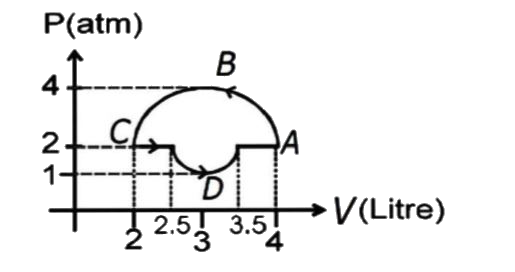Consider the cyclic process ABCA, shown in figure, performed on a sample of 2.0mol of an ideal gas. A total of 1200J of heat is withdrawn from the sample in the process. Find the work done by the gas during the part BC.

−2520J
−3250J
−4520J
−5520J
The correct Answer is:C
n=2,ΔQcyclic=−1200J
AB: isobaric process
ΔWAB=nRΔT=nR(TB−TA)
=2×8.3(500−300)=3320J
CA: isochoric process
ΔWCA=0
ΔWcyclic=ΔWAB+ΔWBC+ΔWCA=ΔWcyclic
3320+ΔWBC+0=−1200
ΔWBC=−4520J
Topper's Solved these Questions
Similar Questions
Consider the cyclic process ABCA, shown in, performed on a sample of 2.0 mol if an ideal gas. A total of 1200 J if heat is withdrawn from the sample in the process. Find the work done by the gas during the part BC.

View Solution
 Consider the cyclic process abca performed on a sample of 2.0 mole of an ideal gas. A total of 1000 cal of heat is withdrawn from the sample in the process. Find the work done by the gas during the past bc.
Consider the cyclic process abca performed on a sample of 2.0 mole of an ideal gas. A total of 1000 cal of heat is withdrawn from the sample in the process. Find the work done by the gas during the past bc.
View Solution
Knowledge Check
A cyclic process performed on one mole of an ideal gas. A total 1000 J of heat is withdrawn from the gas in a complete cycle. Find the work. Done by the gas druing the process B→C.
 A−1531JB−1631JC−1731JD−1831J
A−1531JB−1631JC−1731JD−1831JFind work done by the gas in the process shown in figure :
 A52πatmLB52atmLC−32πatmLD−54πatmL
A52πatmLB52atmLC−32πatmLD−54πatmLFind work done by the gas in the process shown in figure.
 A52πatmLB52atmLC−32πatmLD−54πatmL
A52πatmLB52atmLC−32πatmLD−54πatmL
In figure, a sample of 3 moles of an ideal gas is undergoing through a cyclic process ABCA.A total of 1500J of heat is withdraw from the sample in the process. The work done by the gas during the part BC is −PKJ.FINDP.(R=253J/moleK)

View Solutionconsider the cyclic process ABCA on a sample of 2.0 mol of an ideal gas as shown in the temperature of the gas at A and B are 300 K and 500 k respectively. A total of 1200 J heat is withdrawn from the sample in the process. Find the work done by the gas in part BC. take R=8.3JK−1mol−1

View SolutionCalculate work done is process BC for 1 mol of an ideal gas if total 600 cal heat is released by the gas
is whole process

View SolutionAn ideal gas goes from the state i to the state ∫ as shown in .the work done by the gas during the process

View SolutionIn the cyclic process shown in the figure, the work done by the gas in one cycle is

View Solution
